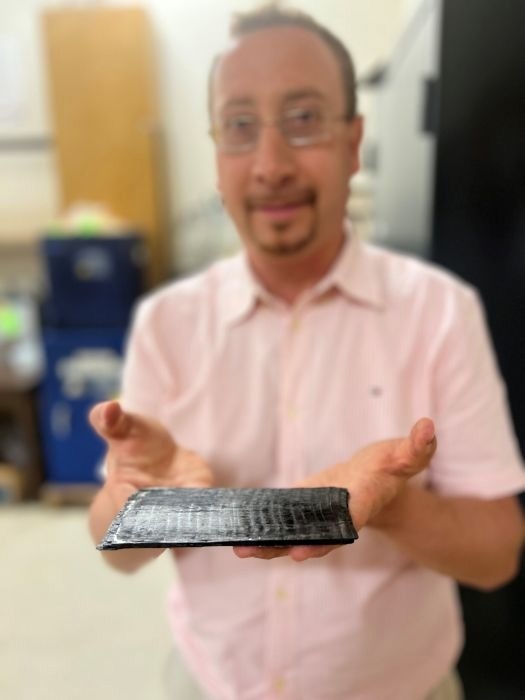Texas A&M researchers have developed an ultra-durable, recyclable smart plastic that heals and reshapes itself, offering major potential for aerospace, defense, and automotive applications.

Dr. Mohammad Naraghi showcasing ATSP, the carbon-fiber smart plastic. Image Credit: Dr. Mohammad Naraghi/Texas A&M University College of Engineering
Published in Macromolecules and the Journal of Composite Materials, Dr. Mohammad Naraghi, director of the Nanostructured Materials Lab and professor of aerospace engineering at Texas A&M, led the breakthrough.
The study investigated the mechanical integrity, shape recovery, and self-healing capabilities of an innovative carbon-fiber plastic composite known as Aromatic Thermosetting Copolyester (ATSP).
What’s really exciting is that this material isn’t just ultra-durable, it’s also adaptive. From on-demand healing in damaged aircraft to enhancing passenger safety in vehicles, these properties make it incredibly valuable for future materials and design innovations.
Dr. Mohammad Naraghi, Professor, Aerospace Engineering, College of Engineering, Texas A&M University
Download your PDF now!
Healing Damage on Demand
ATSP gives up new possibilities in companies where performance and reliability are crucial, and failure is not an option. In aerospace, it could recover from high-temperature stress damage mid-service. In automotive applications, its bond-exchange chemistry can restore vehicle structure after a collision while protecting passengers.
Belonging to a class of materials called vitrimers, ATSP combines the flexibility of thermoplastics with the chemical and structural stability of thermosets. When reinforced with carbon fibers, it becomes several times stronger than steel yet lighter than aluminum. Unlike conventional plastics, ATSP can be recycled repeatedly without losing its chemical integrity.
These vitrimers, when reinforced with discontinuous fibers, can undergo level cycling — you can easily crush and mold it into a new shape, and this can happen across many, many cycles, and the chemistry of the material basically doesn’t degrade.
Dr. Mohammad Naraghi, Professor, Aerospace Engineering, College of Engineering, Texas A&M University
ATSP differs from typical plastics in that it can self-heal and restore its shape.
Shape recovery and self-healing are two facets of the same mechanism. With shape recovery, it refers to the bond exchange within a continuous piece of material — a kind of built-in ‘intelligence.’ And, in self-healing, there’s discontinuity in the material like a crack.
Dr. Mohammad Naraghi, Professor, Aerospace Engineering, College of Engineering, Texas A&M University
The researchers performed a unique stress test known as cyclical creep testing to investigate these material properties. Repeatedly stretching the material, while measuring how it absorbed, stored, and released strain energy, identified two key temperature thresholds.
The first is the glass transition temperature, or the temperature at which the polymer chains can move around easily, and the second is the vitrification temperature. That’s the temperature at which these bonds are thermally activated enough that you can see massive bond exchanges to cause healing, reshaping and recovery.
Dr. Mohammad Naraghi, Professor, Aerospace Engineering, College of Engineering, Texas A&M University
The researchers next performed deep-cycle bending fatigue experiments, occasionally heating the material to roughly 160 °C to initiate self-healing.
Their findings revealed that the ATSP samples not only withstood hundreds of stress and heating cycles without failure but also became stronger during the healing process. In the same way skin heals, the material deformed, healed, and "remembered" its original shape, becoming more durable than its original form.
In another series of tests, the team pushed ATSP through five extreme damage-healing cycles at 280 °C. The material regained nearly full strength after two cycles and maintained about 80 % efficiency by the fifth, with only minor wear from manufacturing defects. Its chemical stability remained unchanged throughout.
The breakthrough achieved by the research team symbolizes more than just an emergent class of materials; it is a template for how daring science and smart collaborations might reimagine a future in which plastics change and adapt rather than just survive.
My students and post-docs do the heavy lifting, I cannot thank them enough. It’s through trial and error, collaborations and partnerships that we turn exciting curiosity into impactful applications.
Dr. Mohammad Naraghi, Professor, Aerospace Engineering, College of Engineering, Texas A&M University
Journal References:
Mandal, T., et al. (2025) Identifying the origin of intrinsic self-healing gradual decay in vitrimer carbon fiber reinforced polymer composites. Journal of Composite Materials. doi.org/10.1177/00219983251362394
Vaught, L. O., et al. (2025) Shape Memory and Fatigue Reversal in a Covalent Adaptive Network Polymer below Glass Transition Temperature. Macromolecules. doi.org/10.1021/acs.macromol.4c02376